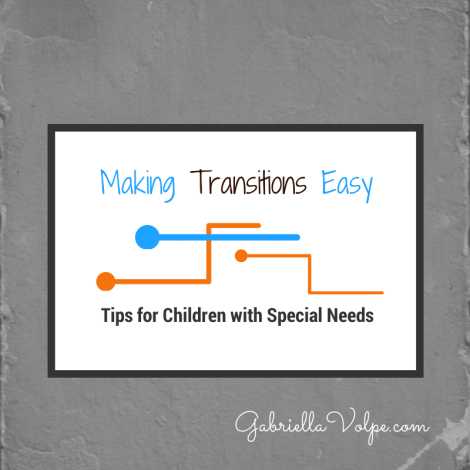 Planning appropriate activities for a disabled child is difficult. It’s doubly as challenging to get a child to go from one activity to the next without completely losing his attention.
Planning appropriate activities for a disabled child is difficult. It’s doubly as challenging to get a child to go from one activity to the next without completely losing his attention.
This post will give you some specific tips when asking your child to break from one activity so that he can focus on another. These tips apply to you whether you’re a homeschooler or an after-schooler of a disabled child.
While you may not think this is a big deal, the truth is you need to have a transition plan in place as much as your regular lesson plans. The benefits of having a transition plan in place are many.
In planning for transitions you:
- teach your child that activities have a beginning, middle and end
- teach your child that life in general has a natural rhythm where things begin and eventually end
- reduce the likelihood of a meltdown
- reduce the power struggle
- make transitions happen in a timely manner
- prepare your child to adapt to transitions that happen outside of the home
- allow your child to become independent
- teach your child to look forward to new things
- infuse some fun into your day
- keep yourself organized as well
Reasons your child might protest a change in activity:
- your child enjoys the activity he is currently working on and doesn’t want to stop
- children with special needs tend to thrive with consistency and predictability
- change is scary and overwhelming
- children with special needs sometimes struggle with following directions due to attention issues
Tips for smooth transitions while doing school work at home:
1- Plan ahead. As stated above, don’t underestimate the powering of planning for transitions. Just as you spend time on lesson plans, you also need to have a clear plan of action for transitioning between one activity and the next- whether that be from one school activity to the next or from one school activity to a home/ life skill activity.
Ask yourself:
- What will I say to my child when I want him to transition? (auditory)
- What will I show my child? (visual)
- What will I say/ do before the activity ends?
- What will I say/ do while we’re changing activity?
- What will I say/ do after the activity has ended?
2- Designate spaces for different activities. I personally don’t like to have to clean-up immediately after each activity. This is because I have to do it myself as my son physically cannot. If I have to clean-up artwork before lunch, my son will not only become impatient, he will have a full-blown meltdown. Because I know this, I have designated spaces that I can leave and return to without having to clean-up immediately.
For instance, we have:
- an adapted art table (for fine motor activities)
- an adapted feeding chair with tray (for meals)
- a dining room table (for resting whatever on)
- a kindergarten table with an chair insert (for reading in his room)
- a rocking chair (for snuggling before rest)
- the floor play area (for free play)
- the basement (for gross motor play)
- a little nook by the stairs (for floor-time activities)
Having these spaces cuts the time it takes to shift from one activity to the next.
Even if you do not have a large home, you can use different corners of each room in different ways. Sometimes, just having a rug in a certain spot creates an activity zone.
3- Use visual schedules. If your child can cognitively understand the progression of time, having a visual schedule up is highly beneficial. At the beginning of each day, you can prepare your child with what will happen by pointing and labeling each of the steps in the schedule. “Look, Billy. Today, we’re going to eat breakfast, then, get dressed, then, brush teeth, comb hair, then math …” I highlighted the words that you’ll be stressing, so that the rhythm becomes predictable.
Things to keep in mind when making/ using visual schedules:
- If you’re just beginning with visual schedules, use objects to represent each activity. For instance, a spoon, a doll’s shirt, a toothbrush, a comb and a number cut-out could all represent the activities I outlined in the example above. You can either lay the items down across a table, Velcro them to a poster or tape them vertically on a wall. When you refer to this object schedule, pick up each item and say (and possibly sign), “eat breakfast, get dressed, brush teeth, comb hair, math”. Note: If your child uses AAC, by all means, create a visual schedule on his device. (You can find links to two apps that I suggest for this purpose in the resources at the end of this post).
- Use images of items your child is familiar with to begin (i.e.: take photos and laminate them). Use illustrations only if your child understands their symbolic nature.
- Label the images with one or two words so that whoever uses the schedule uses the same words (i.e.: mom, dad and grandma will all say, “Get dressed” rather than one person saying “Get dressed” while others say, “Put your clothes on”. Keep it consistent for all who use the schedule).
- Reuse the same cards so that you’re not creating new ones on a daily basis. Think about what your week will consist of, and create cards for each situation. Things to think about include: morning routine, meal routines, rest, bedtime, the subjects, going out, cleaning up, etc. Don’t make it too detailed to begin. Stick to about 6-8 cards, then increase as your child understands more and perhaps requires more specific cues.
- Refer to the schedule throughout the day, not only in the morning. After each activity, walk to the schedule and say, “Next, brush teeth.” If this type of movement is too much, bring the two cards you will need to your child. Show the activity he’s doing now, and what will come next.
- If you’re up to it, and if your child benefits from micro-schedules, include one in the area where your child will most need to refer to it. For instance, keep a grooming schedule in the bathroom (brush teeth, wash hands, comb hair, etc.), a getting dressed schedule in the bedroom, a taking a bath schedule next to the bathtub, etc.
The goal of these types of schedules is to help build autonomy so that your child can learn to use them on his own. He will eventually internalize the rhythm and begin to expect that something new is about to transpire.
If your child is used to them, use social stories to teach him how to transition from one activity to another.
4- Use props to signal the next activity. Signal a change in activity with a prop.
Props can be:
- fun glasses
- hats
- capes, aprons or smocks
- objects related to the next activity or story
- a timer
- clappers
- bells, chimes or other musical instruments
- humming/ singing
- music
For a child who obsesses about his work needing to be finished before moving on, allow for extra time, but signal the change coming up (ex: lunch time). A timer (digital or analog) kept close-by works best for these types of children. But, for someone like my son, who does not comprehend the concept of time in terms of a clock, you can try the following:

Use thematic hats, glasses, headbands, aprons, and sweaters to make the transition eye-catching. Use them at the same time each day (ex: to signal story time), to make their use and the transition predictable. Props like these give a child who doesn’t understand the concept of time (in terms of a clock) a concrete, visual signal. Just be sure to use it consistently/ at a specific point within the rhythm of your day.

Use musical instruments as props for transitions to allow you to signal a new activity without words. A gentle chime or the trickling sound of the rain stick gets your child’s attention in a calm and peaceful fashion. If you don’t want any sound at all, consider waving a silk scarf or a ribbon wand.
5- Use movement while transitioning. Movement in this context is also referred to as brain breaks. To make it interesting for your child (and, let’s face it, for yourself too), add exaggerated movements as you move from one activity to the next.
Some ideas for transitioning with movement:
- stomp over to the lunch table
- wiggle over to the sink
- hop to the art table
- do “the robot” while gathering math materials
- make funny faces while waiting for the video to begin
- take deep breaths while getting jammies on
- sing a clean-up song while picking up toys
- pat self on the back when completing an activity
- dance just for the fun of it
- do a series of jumping jacks to signal outdoor time
- walk like a crab, backwards to the play area
- tap head with one hand and rub tummy with other while walking to the bathroom
- hum the tune to a favorite song while baking
Even if your child cannot walk, you can try variations of these activities while transporting your child (do it safely, of course). I enjoy “bounce-bounce-bouncing” from one activity to the next.
[pullquote]Transitions are a great time to take brain breaks. And, brain break activities with predictable/ rhythmic movement such as these above are great for providing vestibular input for children who struggle with sensory/ nervous system regulation.
It doesn’t matter what age your child is, all children function better when they know what to expect.
What do you do to make transitions easier for your child?
Resources:
- First Then Visual Schedule – a simple visual schedule app that you can add your own voice and pics to.
- Visual Schedule Planner – a more advanced visual schedule app where you can add photos and many tasks.
Disclaimer: The app links above are affiliate links which means that if you make a purchase on iTunes using these links, I get a little commission, at no extra cost to you. Thank you for your support.


0 Comments